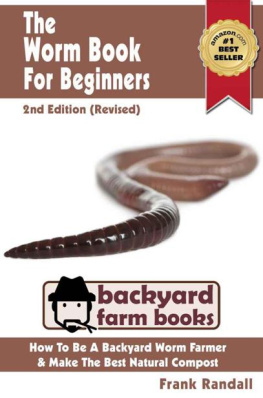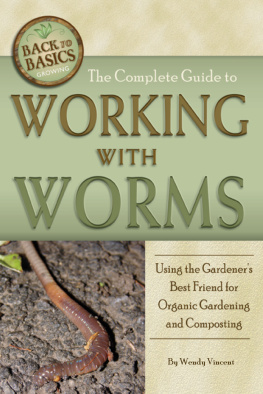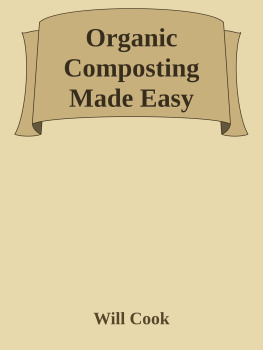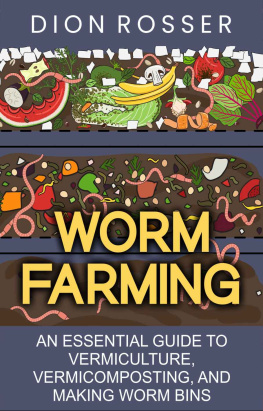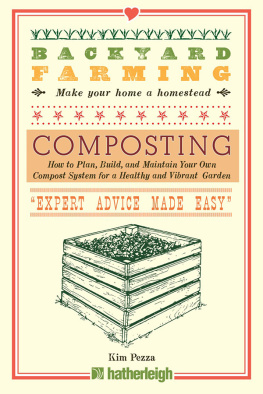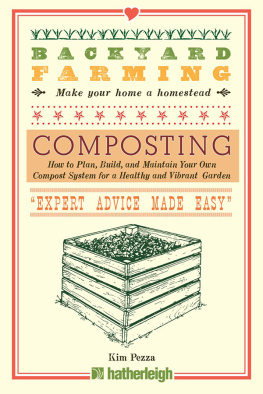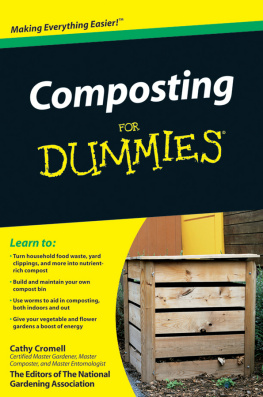The Worm Book For Beginners
A Vermiculture Starter
Or
How To Be A Backyard Worm Farmer
And Make The Best Natural Compost
Second Edition (Revised)
Frank Randall
Copyright 2012
Copyright
Copyright 2012 Frank Randall & 3D4T - All rights reserved.
This Kindle book contains material protected under International and Federal Copyright laws and Treaties. Any unauthorized reprint or use of this material is prohibited.
Unauthorized duplication or distribution of this material in any form is strictly prohibited. Violators will be prosecuted to the fullest extent of the law.
No part of this publication may be reproduced, stored in a retrieval system or transmitted in any form or by any means, electronic, mechanical, photocopying, recording or otherwise, without prior written permission from the author/publisher.
The author, publisher, and distributor of this product assume no responsibility for the use or misuse of this product, or for any physical or mental injury, damage and/or financial loss sustained to persons or property as a result of using this system. The liability, negligence, use, misuse or abuse of the operation of any methods, strategies, instructions or ideas contained in the material herein is the sole responsibility of the reader.
The material contained in this publication is provided for information purposes only.
Contents
1 - Worm Biology 101
Although some people may not be thrilled with the concept of raising worms, most good gardeners love the idea. Thats because worms are like Mother Natures recycling center. They feed on bacteria attached to the worlds scraps and leftovers and the resulting worm manure (or castings) is rich in nutrients.
Worm composting, also called vermicomposting or vermiculture, is especially popular in areas where soil quality may not be the best. Keeping a worm box and making your own nutrient-rich soil can be the difference between having a few sickly plants in your yard or growing a beautiful garden full of vegetables and flowers.
Worm Anatomy
Worm anatomy is actually quite interesting. First of all, worms have segmented bodies, which enable them to move across the ground. Their movement is similar to a person climbing rocks; one segment will grab some soil using small hairs and the other segments will swing around and grab another clump of soil to move forward.
Its the ability of each segment to individually grip the soil that makes the worm appear to wiggle as they move. It also gives the worm complete flexibility and the ability to even bend backwards if needed, like a snake striking at prey.
The Head Segments
Each body segment of a worm has certain functions assigned to it. Segments one through five contain the mouth, brain, and pharynx. Worms have no eyes, but they can sense light and dark thanks to light sensitive tissue on their head. Since they prefer the dark, worm composters leave the lid of a worm box open, because the light causes the worms to burrow further down into the dirt pile, in turn making them more productive.
The Circulation Segments
There are three main vessels that supply the blood to a worms organs: the aortic arches and the dorsal and ventral blood vessels. There are five pairs of aortic arches, which work like a heart, pumping blood into the dorsal and ventral blood vessels. The dorsal vessels carry blood to the front of the worms body, and the ventral vessels carry blood to the back. The worms aortic arches are located in segments 6 through 10.
Intestinal, Respiratory and Reproductive Segments
The digestive system is located in segments 11 through 20, and is comprised of a pharynx, esophagus, crop, intestine, and the gizzard. A worms mouth has an attached appendage, or wedge, that pushes food into the mouth. Worms dont have teeth to chew so food is swallowed by the pharynx. It then passes through the esophagus and into the crop where it is stored. Eventually, the food will move into the gizzard, where small stones swallowed by the worm will grind the food, before sending it along to the intestines. Digestive fluids in the intestines break down the food even more so it can be absorbed by blood vessels in the intestinal walls.
Segments 11 through twenty 20 also control a worms respiratory system. Instead of lungs, there is a layer of moist cells that diffuse oxygen and carbon dioxide.
Adult worms use part of their last segment areas for reproduction. Worms are hermaphrodites, meaning they can function as both male and female. However, contrary to popular belief, most worm species cannot reproduce on their own this process is called parthenogenesis. The types of worms that you need for composting, require other worms to reproduce.
During the mating process, a ring called the clitellum forms around the worm, which will then back out of the ring, creating a fertilized cocoon. Each cocoon will incubate around two to three weeks. Then the egg capsules hatch, releasing new worms.
Each egg capsule can create anywhere from two to twenty new worms, so it can be difficult to accurately estimate how many worms you will have as time passes. However, studies suggest the average is four to five worms per egg.
Life Span and Population Growth
Worms can live up to 20 years. Since they multiply quickly you should expect considerable population growth. It is generally a good idea to start composting with only a small amount of worms, and then sit back and watch the population grow.
When to Feed the Worms
Worms cant survive on the same small box of soil forever, and will tell you when its time to feed them some new soil. The worms will start at the bottom of the compost pile and work their way up, so simply change the soil when they get to the surface or just below it.
You may have decided to take up worm composting in order to help your garden grow, or to do your part to protect the planet. However, you can also get a great deal of enjoyment just watching the worms work, because the vermicomposting process is really quite remarkable to experience.
2 - What Kind Of Worms Should I Use And How Many Will I Need?
If you want to start composting with worms, youre going to need a composting box, bedding, food, and a few other minor things. The vital component in worm composting, of course, is the worms themselves.
Selecting Your Worms
Avoid getting regular night crawlers, which are the worms found in most gardens. They dont normally eat organic waste, and they dont do well in the warm temperatures that are usually present in a compost box.
One of the best and most popular composting worms available is Eisenia fetida, the red worm, also known as:
- Red wigglers
- Tiger worms
- Brandling worms
- Manure worms
Unlike an average night crawler, red worms can withstand a wide range of temperatures, from 32 o to 95 o F (0 o 35 C). Its best for the worm box to be at the warmer end of the temperature range, which encourages the worms to dig down deeper into the soil where they act as recycling centers, and turn the waste materials into compost.
Another option is the European night crawler, Eisenia hortensis. They are also referred to by other names, including:
- Euros
- Belgian night crawlers
- ENCs
As the name suggests, Eisenia hortensis is more popular in Europe, but it is gaining a following in North America as well. However, some studies suggest they arent quite as efficient as red worms, and dont reproduce as quickly either. But there are plenty of people who compost with worms that dont report a noticeable difference between the two species, so it really is a personal choice.
Determining How Many Worms You Need to Start

